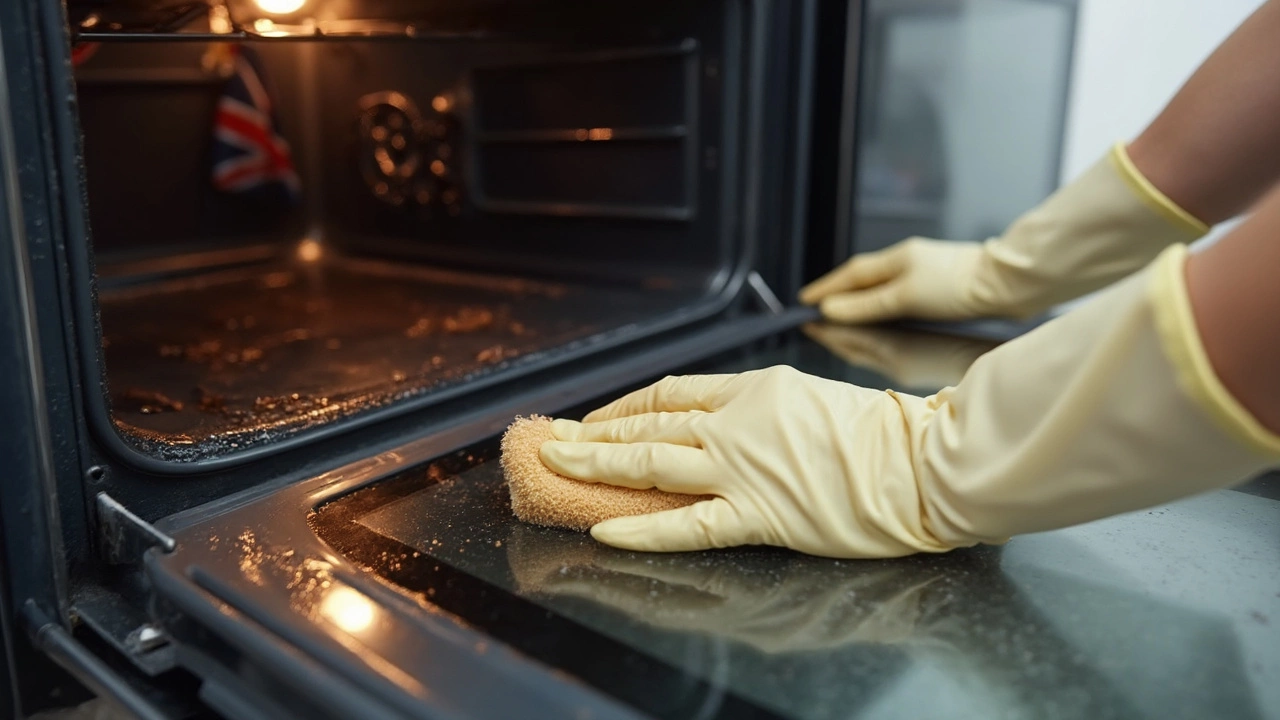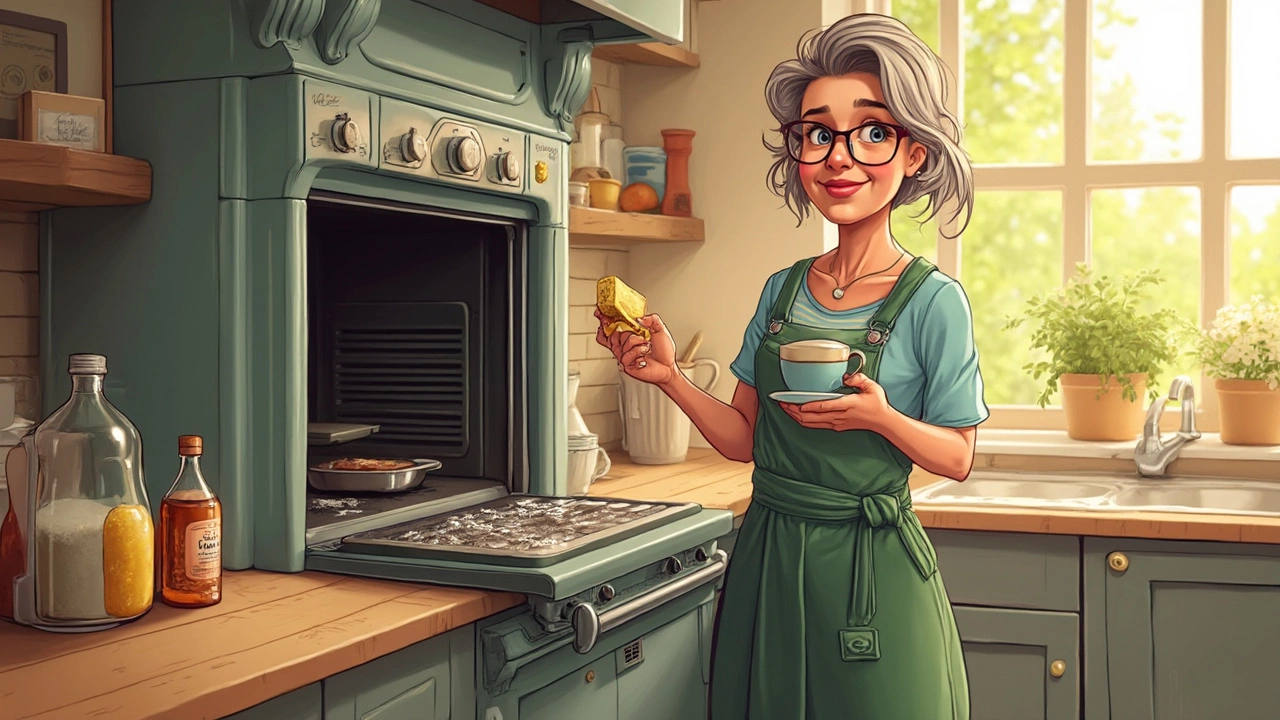There’s nothing quite like the smell of fresh cookies—until you catch a whiff of something burnt every time you turn on the oven. Burnt stuff on the oven bottom is more than just an eyesore; it messes with flavors and can fill your kitchen with smoke. Whether it’s drips from last night's lasagna or runaway cheese from a pizza, let’s get it off the easy way.
First things first, skip the power tools and weird miracle sprays. Most of the time, regular items you already have at home do the job just fine. Baking soda, vinegar, and a little patience get you most of the way. One thing nobody tells you: making a baking soda paste works better than just sprinkling powder. Plus, it's safe for kids and pets—like my dog Charlie, who loves sniffing around when I clean.
And here’s a simple truth: more scrubbing doesn’t always mean better results. If burnt stuff is caked on, let your cleaning paste do the heavy lifting instead of hurting your hands. Give it time to work—grab a coffee, catch your breath, and let chemistry do its thing. You’ll save energy and avoid scratches inside your oven. That’s way smarter than using steel wool, which just leaves your oven looking worse.
- Why Does Food Get Burnt Onto the Oven Bottom?
- Best Tools and Supplies for the Job
- Step-by-Step: Cleaning Burnt Gunk Off
- Danger Zones: What Not to Do
- Tips for Keeping Your Oven Clean Longer
Why Does Food Get Burnt Onto the Oven Bottom?
It usually starts with drips or spills from whatever you’re cooking. If you’re roasting chicken, cheese from a pizza slides off, or you overfill a casserole dish, that stuff falls straight onto the oven bottom. Once it hits around 400°F (204°C), it cooks onto the surface, dries out, and turns to carbon—basically burnt gunk that’s nearly glued on.
Sometimes, people think it’s just bad luck, but there’s a pattern. The hotter the oven, the faster things burn on. Plus, sugary sauces and fats are the real culprits because they caramelize and stick worse than just bread crumbs or veggies. Pretty much every modern oven—gas or electric—deals with these stains because heat circulates around the oven and bakes whatever’s on the floor even harder.
- Pizza cheese leaks? Hardens into a crusty mess quick.
- Spilled pie filling? Turns like glue after a few cycles.
- Oily marinade drips? Doubles down by baking greasy residue into the metal.
Here’s a quick look at how common spills create stubborn stains:
| Food Type | Temp (°F) | Effect |
|---|---|---|
| Cheese | 375-450 | Hardens, burns fast |
| Sugary sauces | 350-400 | Caramelizes, sticks stubbornly |
| Oils/fats | 350+ | Leaves greasy, baked-on film |
Some folks try to use foil on the oven bottom, but manufacturers warn against it. It can mess up how the heat flows and even damage the heating element. So it’s better to clean oven messes right away if you can—but when you can’t, understanding how these burnt layers form is the trick to getting them off. If you’re searching for tips on how to clean your oven, knowing the root cause saves you serious hassle down the line.
Best Tools and Supplies for the Job
So how do you actually get burnt stuff off the oven bottom without ruining it? You don’t need high-end cleaning gear—most stuff you need is probably already in your pantry or under your sink. Here are the real MVPs for cleaning out even the toughest oven messes.
- Baking soda: This is your go-to. It’s cheap, safe, and works better than half the commercial oven cleaners out there. It breaks down gunk without scratching the surface.
- White vinegar: When you mix this with baking soda, you get a fizzing reaction that helps lift stubborn burnt bits. Plus, no harsh fumes or chemical smell.
- Spray bottle: Makes it way easier to apply vinegar evenly over the baking soda paste. You don’t want to just dump it on (unless you like cleaning more mess).
- Old sponge or dishcloth: Don’t use your good one—it’ll probably never look the same after. Soft is better here to avoid scratches.
- Plastic spatula or scraper: Forget metal tools (they’ll scratch enamel or leave marks). Plastic is tough enough to loosen burnt bits, but gentle on the oven.
- Rubber gloves: This keeps your hands from getting gross, especially if you’re dealing with old, greasy spills.
- Paper towels or an old towel: For the final wipe down so you don’t leave a film behind.
I should mention, commercial oven cleaners do exist and can save time, but read their labels—some aren’t safe for self-cleaning ovens or leave behind strong fumes. And don’t fall for "oven liner mats." If they aren’t rated for high heat, they can melt and turn one mess into another.
Stick with these tried-and-true supplies, and you’re way ahead of the game. Cleaning your oven doesn’t have to be fancy or complicated—it just needs the right tools and a little know-how.

Step-by-Step: Cleaning Burnt Gunk Off
Getting burnt crud off the oven bottom isn’t rocket science, but a method keeps things simple—and it actually works. Here’s how you can reclaim your oven without any hassle.
- Safety first: Flip the oven switch OFF and make sure it’s cool to the touch. You do not want to burn yourself or melt your sponge before you start scrubbing.
- Remove oven racks: Slide them out and set them aside. Give them a soak in hot soapy water if they’re grimy too.
- Quick sweep: Using a handheld vacuum or even a dry cloth, get rid of all the loose, flaky stuff. Don’t let it get wet or you’ll have a sticky mess.
- Make a paste: Mix half a cup of baking soda with a few tablespoons of water until it’s the same consistency as toothpaste. That’s your gunk-busting secret weapon. Smear it right onto any burnt spots on the oven bottom—don’t skimp!
- Let it sit: Give it at least 8-12 hours (overnight is perfect). The paste breaks down the burnt-on mess, so you don’t have to use brute force.
- Wipe it out: Dampen a regular kitchen sponge or rag, and wipe up the dried paste. Most of the burnt stuff should lift right off with it.
- Tough spots? Spray a little vinegar onto any leftovers. Fizzy action helps loosen leftover bits. Wipe again with a clean cloth.
- Dry it down: Once the gunk is gone, use a dry rag to make sure there’s no baking soda residue. Pop the racks back in, and you’re done.
This method gets talked up because it’s safe—even if you’ve got curious pets or allergies at home. No harsh fumes, no weird smells, and you don’t have to play chemist. Plus, you’re not risking the oven’s heating element or fancy finish.
Here’s a quick look at how long each step usually takes for most people:
| Step | Time Needed |
|---|---|
| Remove racks, sweep debris | 5 minutes |
| Mix & spread baking soda paste | 10 minutes |
| Let paste sit (do nothing!) | 8-12 hours |
| Wipe & spot clean | 15 minutes |
The best part? You probably already have everything you need. If you clean up the worst messes right away, you won’t end up needing a full-day project next time you tackle oven cleaning.
Danger Zones: What Not to Do
Scraping burnt messes off your oven may seem simple, but there’s a right and wrong way. Let’s cut through the myths and talk about what to avoid if you actually want a working, safe oven in the end.
- Don’t use metal scouring pads or steel wool. Sure, it feels tough, but you’ll scratch up the enamel inside your oven. Once that finish is wrecked, burnt food will stick even more the next time.
- Say no to knives, razor blades, or anything sharp. These things can easily gouge the oven bottom or chip pieces off the coating. No one wants extra metal bits in tonight’s dinner.
- Trying to blast burnt stuff loose with the self-clean function when your oven is very dirty? Big mistake. The intense heat can actually make burnt gunk even harder to remove or smoke out your kitchen. Plus, if there’s too much build-up, you risk tripping the thermal fuse—which leads to a dead oven and a costly repair.
- Never mix commercial oven cleaners with homemade stuff like vinegar or baking soda at the same time. Mix them up and you’ll get weird, sometimes toxic, reactions. Stick with one method, rinse, and only then try something else if you need to.
- Don’t clean a hot oven. It’s tempting to start right after baking, but you’ll end up with burns or inhaling nasty fumes. Wait until it cools down.
Here’s a quick snapshot of oven mishaps and what usually happens:
| What People Try | What Goes Wrong | Recommended Alternative |
|---|---|---|
| Steel wool scrubbing | Scratched enamel, hard to clean later | Use a soft sponge or nylon pad |
| Self-cleaning with lots of build-up | Smoke, kitchen smells, blown fuse | Remove large messes first |
| Mixing cleaners | Unpredictable reactions, toxic fumes | Stick to one cleaner at a time |
| Scraping when hot | Burns and steam injuries | Wait for oven to cool |
One last thing: always double-check your oven’s manual for tips or warnings specific to your model. Manufacturers sometimes hide useful nuggets in those little books, especially about safe cleaning ways. Getting burnt stuff off your oven bottom is all about patience and using the right tool—not muscle and risky shortcuts.

Tips for Keeping Your Oven Clean Longer
If you're tired of scraping up burnt-on messes from oven spills, there's good news. While deep cleans are sometimes needed, a few habits can keep things way easier.
- Oven cleaning is way less work if you catch spills early. Put a sheet of aluminum foil or a baking tray on a lower rack, but never directly on the oven bottom. This catches drips before they burn on, and it won’t mess with air flow like laying foil on the floor does.
- Use oven-safe mats or liners. Silicone oven liners are a lifesaver—they go on the lower rack, are nonstick, and you can pull them out to wash by hand. Just double check your oven's manual first. Some brands warn off using liners because they can block vents if put in the wrong spot.
- Wipe up crumbs and spills while the oven is just warm, not hot. Use a damp cloth with plain water. Once things cool completely, spills get harder to remove. Skip harsh scouring pads so you don’t scratch up the surface.
- If you roast or bake juicy dishes, slide a tray under your main dish. This especially helps with things like pies, lasagna, and casseroles that love to bubble over.
- Get in the habit of cleaning every couple of months or after a messy cook-up. Don’t wait until burnt stuff starts to smell or smoke.
Curious what causes ovens to get dirty most? Here's a quick look at what trips people up:
| Common Culprit | % of Oven Messes |
|---|---|
| Cheese Drips (Pizza, Lasagna) | 34% |
| Baked-On Grease (Roasts) | 27% |
| Pie Overflows | 14% |
| Forgotten Bread Crumbs | 12% |
| Sauces & Marinades | 13% |
Lastly, don’t ignore regular maintenance. If your oven has a self-clean cycle, use it every few months, but still wipe out big pieces first so you’re not cooking the gunk even harder onto the walls. Consistent quick cleans mean you won't face a big job down the road.
